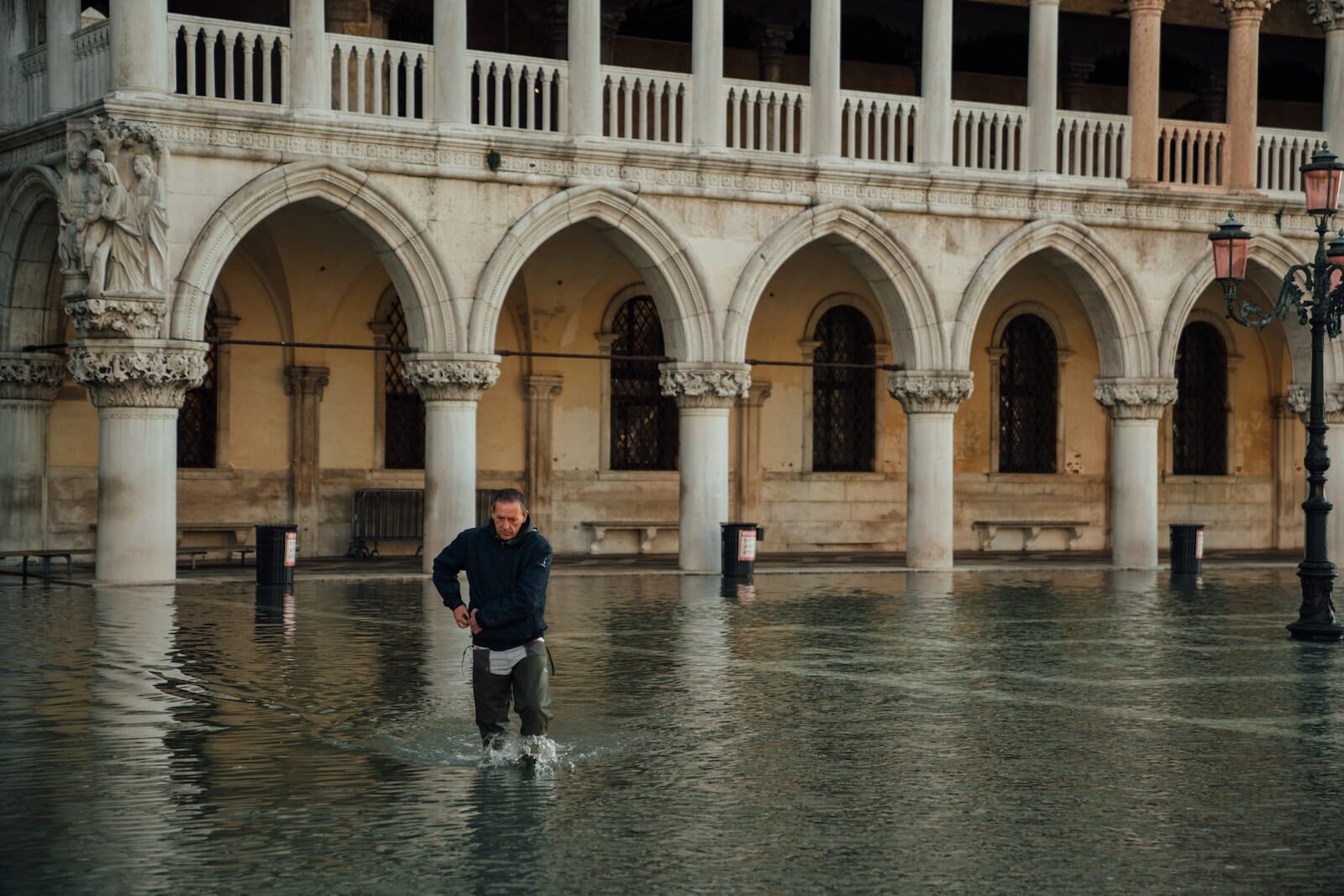
Once again, Venice’s acqua alta is all over the news. Rising water levels in Piazza San Marco disrupt daily life for locals – and throw a wrench in visitors’ carefully planned itineraries. So what can you do when flooding inundates the Floating City?

Flooding St. Mark’s Square can be shocking – and really throw a wrench in your travel plans. Photo credit: Egor Gordeev
First, it helps to have a solid understanding of why Venice floods – and how the impact of flooding has changed in the past few decades. In 2019, Venice’s acqua alta got up to 187 cm (6 ft 1 inch), the second-highest level of flooding ever recorded. At that time, more than 80 percent of Venice was under water! This left many devastating, long-lasting impacts on the city. Current efforts to correct flood damage include a €3.3 million Euro restoration of St. Mark’s Basilica.
While recent floods haven’t been quite so extreme, they can still create massive changes to your travel itinerary. Keep reading to learn how to deal with Venice’s acqua alta.
Table of Contents
ToggleA guide to surviving Venice’s acqua alta
The pictures are stunning: people swimming through St. Mark’s Square, merchandise floating in shops, locals paddling to work. But what is it really like to visit—or live in—Venice when there’s acqua alta? Here’s our step-by-step survival guide!
What is acqua alta?
Acqua alta literally means “high water”—and that’s what it is! Because of Venice’s unique position as an island criss-crossed with canals, the city is, of course, very sensitive to water levels. So whenever water levels rise in the Venetian lagoon… the island of Venice is at an increased chance of flooding.
Acqua alta usually happens in the winter, thanks to a combination of the tides, a strong south wind, and the periodic movement of sea waters. But it’s been happening more often—and been getting worse—in recent decades, thanks to Venice’s sensitivity to climate change.
In 2012, it was discovered that the island was sinking at an alarming rate – 2 millimeters per year! This was five times faster than previously thought. While that might not sound like much, it adds up. The Rialto Bridge, for example, has sunk 1.7 meters (5 feet) since it was first built.
Venice is sinking partly because, thanks to climate change and the melting of the glaciers, water levels are rising worldwide at a rate of 0.14 inches per year. And it’s partly because of issues particular to Venice itself, like the industrialization of adjacent Mastre-Marghera and the increase of pumping water and natural gas from the ground.
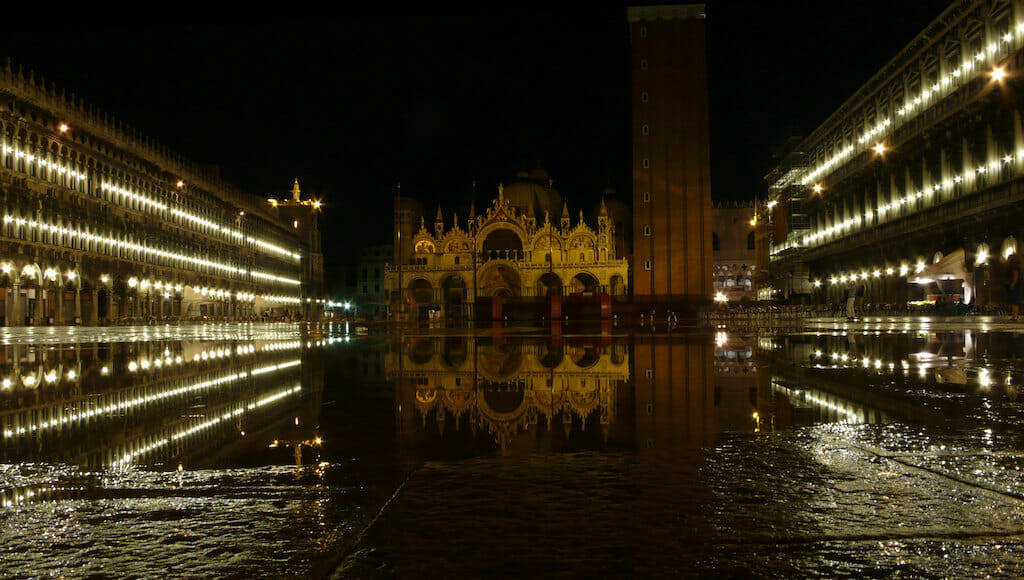
Flooding in Piazza San Marco, one of the lowest areas of the city. Photo credit: Kyle Van Horn
How often does acqua alta occur?
Statistically, exceptional high tides—when the water level of the lagoon is 140 cm or more above the standard sea level, the point at which more than half of the island of Venice is flooded—only happen once every four years. But more minor flooding occurs much more often: Water reaching 110 cm, at which point flooding covers 14 percent of Venice, happens about four times a year.
In general, if you’re coming during the winter, particularly November or December, you should be prepared for the possibility of acqua alta.
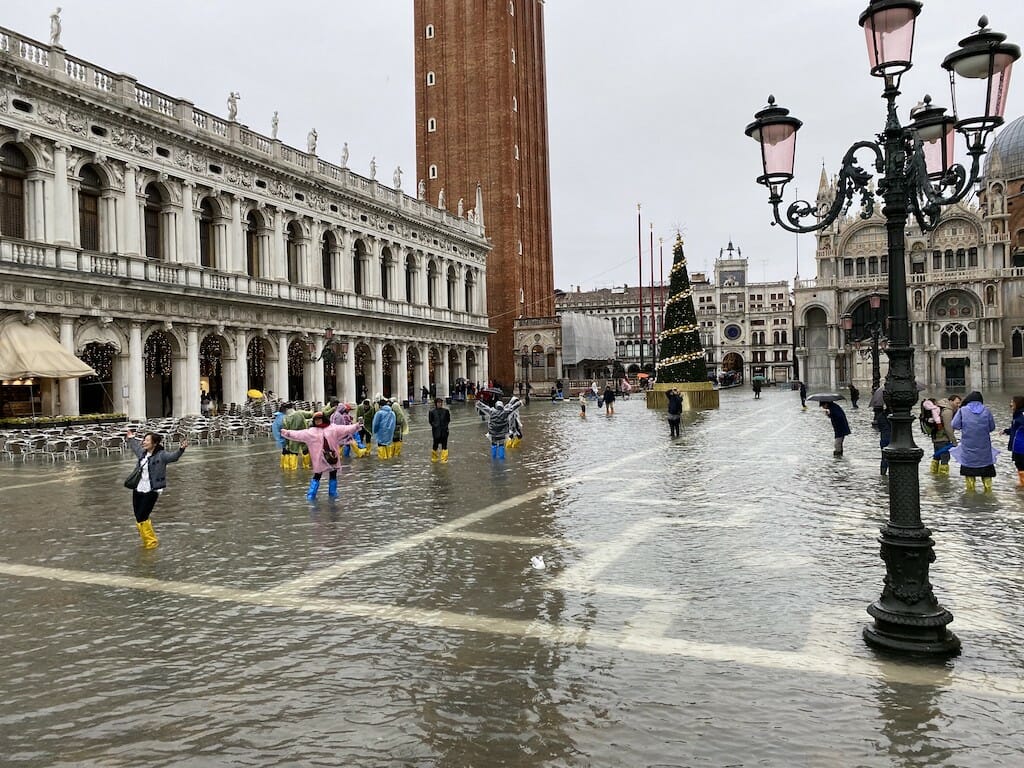
Venice’s Acqua Alta during Christmastime. Photo credit: Erin McCormack
How long does acqua alta last?
It generally lasts for only a few hours—but not always! It depends on the neighborhood and how hard it was hit.
How do I know when acqua alta is going to hit Venice?
Those who live in Venice are notified by the city by phone or SMS. But if acqua alta is estimated to be particularly bad, everyone gets notified, thanks to a system of sirens that sound throughout the island. Keep your ears open for any whistles – the more whistles there are, the worse it’s going to be. You can also check online at Venice’s acqua alta forecast website.
And, of course, you can always ask your hotel what the likelihood is that acqua alta is coming—you can bet that they’ll know!
How do I get around when Venice is flooded?
Remember that, in all likelihood, half, or more, of the island will be dry. That said, the area around St. Mark’s Square is the lowest on the island, and therefore the first to get flooded. If you must pass through the flooded areas – or you simply want to see what it looks like – use the passarelle, which are elevated walkways above the water that indicate pedestian paths. (Please, walk on the right-hand side to avoid being an obstacle to locals.)
You’ll probably get a little wet regardless–the passarelle don’t always connect at every point—but it’ll keep you out of the worst of it.
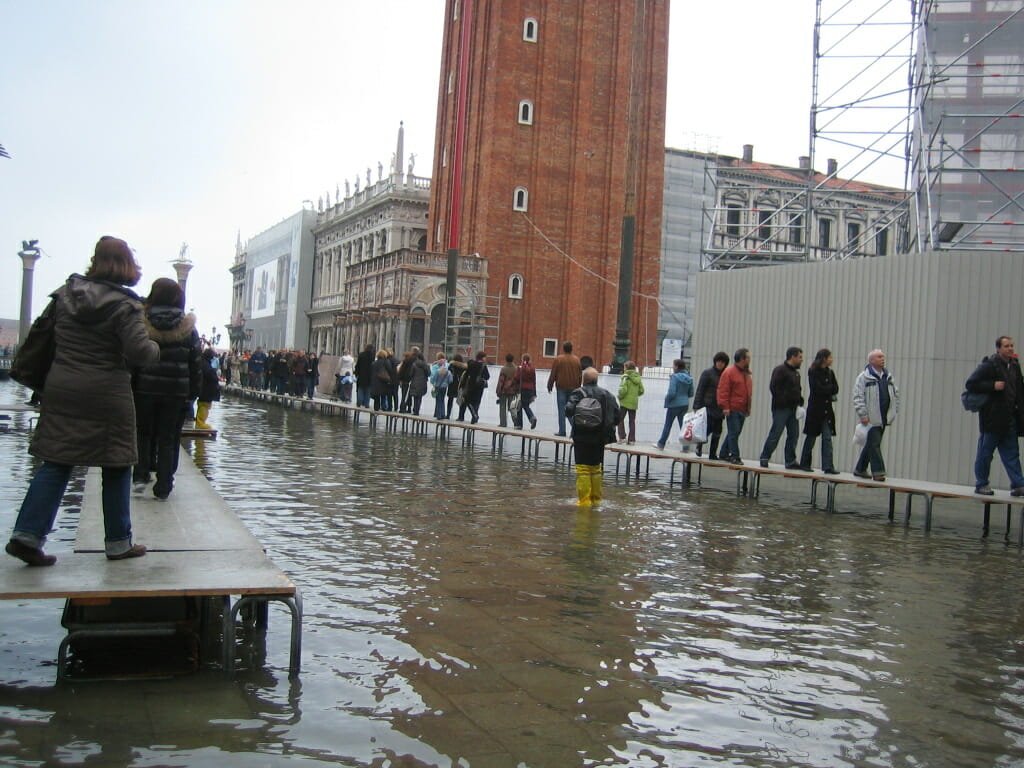
Navigating Venice by passarelle. Photo credit: WorldIslandInfo.com
Should I pack my rain boots?
Not necessarily! Again, remember that, even in terrible flooding, some of the island will most likely remain dry. So many people prefer to wait out the acqua alta at their hotel or in a drier part of town. Otherwise, of course, rain boots can come in handy; however, they aren’t a travel essential and take up lots of suitcase space.
Instead, if you discover they’re necessary, you might consider buying them when you get to Venice. Some hotels are even kind enough to loan rain boots to guests.
Forget staying dry—this seems like a fun opportunity to swim in St. Mark’s Square and take some great photos! Is it?
No, not at all. This is unsafe.
First of all, remember that the water is going to be very cold. Secondly, it’s very dirty—something you’ll probably notice as soon as you see it, since it often comes with garbage and other debris floating. Remember, this is water that’s swept through not only Venice’s piazzas, but its garbage cans, stores, and more.
Full of bacteria, it’s probably not something you want to submerge your body in! And no, the smell often isn’t great. To be safe, forget about swimming and avoid going barefoot in the flooded areas.
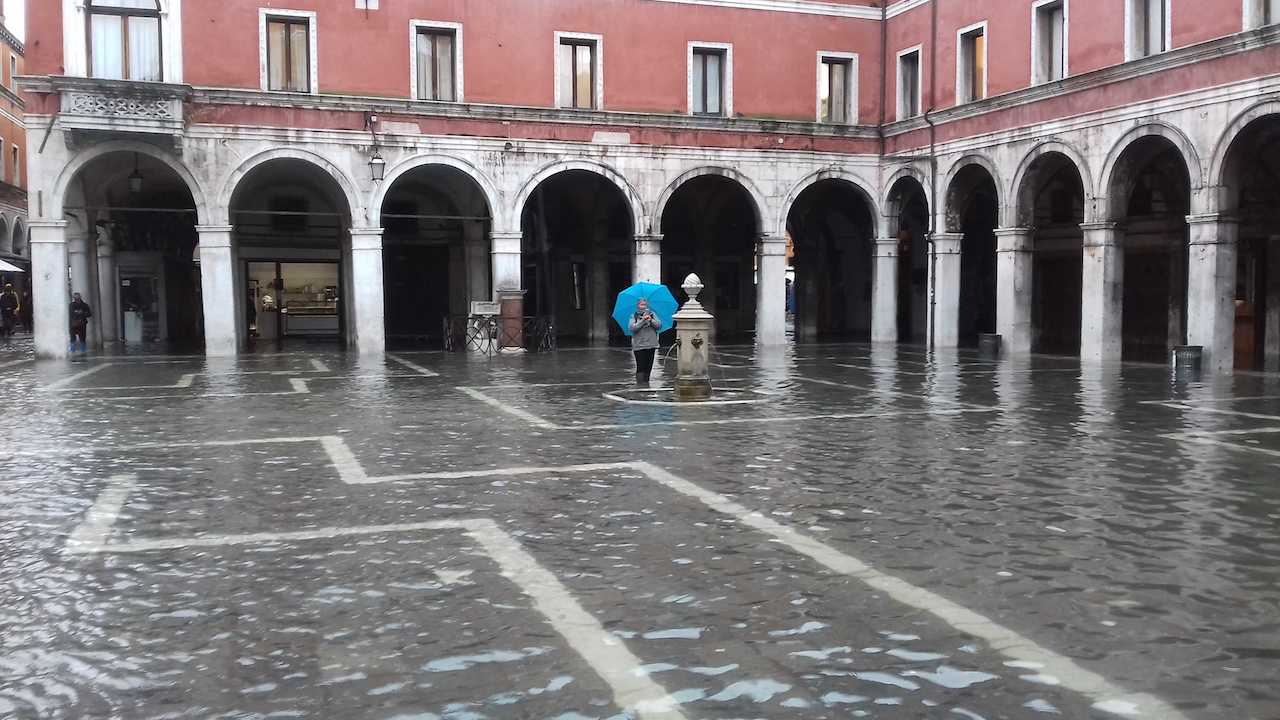
Avoid swimming during Venice’s acqua alta, or high tide. Photo credit: Celine Zancanella
What happens to transportation and sights?
In many ways, Venice trundles on as usual during acqua alta. But some things are hindered. Boats run, but might have to change their routes, because they may not be able to pass under some bridges. And some stores, restaurants, and sights might be forced to close temporarily.
What does acqua alta mean for how much I should pack?
Strange question? Not really! Many people don’t think about what they’ll do if they get to their hotel… and the walk there is flooded. The option to wheel your suitcase vanishes—unless you want to get it soaked. So you need to be strong enough to carry it above your head. Something to keep in mind if you’re visiting Venice in the high-risk months.
Any other tips?
Yes—be careful if you’re walking on flooded sidewalks next to canals! Because of the flooding, it’s often harder to see the edge between the land and the canal. Watch your step if you want to avoid getting really soaked.
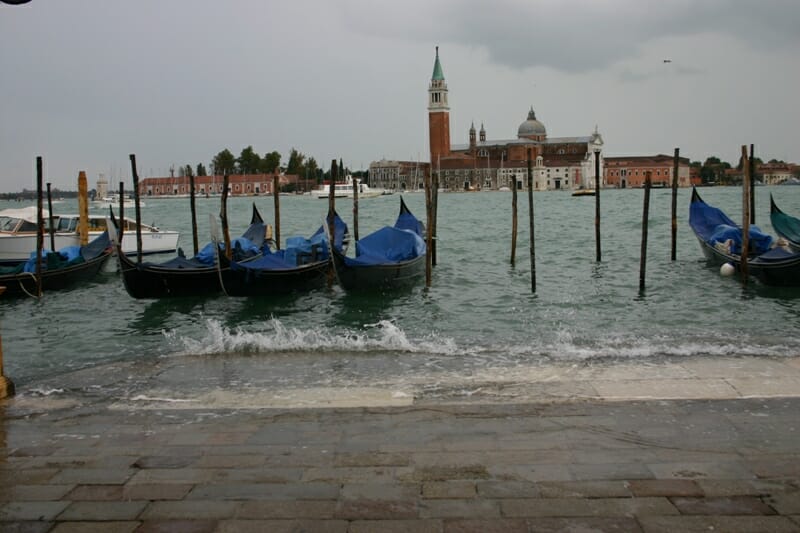
During acqua alta, it’s not always that easy to tell where land stops and the canal begins! Photo credit: Matt Howry
What can I do to help with flooding in Venice?
Although it is, in many ways, a part of normal Venetian life, acqua alta is also devastating. The forecast for the sinking city isn’t looking good.
So, if you love Venice – or simply want it to be around for your grandchildren to visit – consider helping by supporting Venice in Peril. This non-profit organization aims to conserve the Floating City’s precious spaces and monuments – including those damaged by floods. Becoming a member also gives you access to events, lectures, galas, and more.
This all sounds pretty serious. What is being done about high tides in Venice?
Great question! One major project to try to protect Venice—and its delicate monuments, churches, and palaces—from future flooding is MOSE. This huge engineering undertaking, which stands for Experimental Electromechanical Module, was built to the the tune of more than 5 billion Euros. It consists of three strategic floodgates that cut off the Venetian lagoon from the Adriatic Sea during high tides.
Critics say that the project didn’t take into consideration how much the sea levels are slated to rise – a scary prospect, indeed. And during 2019’s epic floods – a time the gates were theoretically ready to use – MOSE unfortuantely failed to protect Venice from acqua alta.
Since 2020, however, reports have been more positive. These protective barriers now go up as frequently as needed to save the city from extreme flooding. What travelers need to keep in mind, though, is that some lower parts of the city still flood easily, and that MOSE isn’t a blanket solution to all of the city’s water issues.
Don’t miss our video on what it’s like to be a local and live on Venice’s canals – acqua alta included!
Update notice: This article was updated on August 28, 2023.
by Elena L.
View more by Elena ›Book a Tour

Pristine Sistine - The Chapel at its Best
€89
1794 reviews

Premium Colosseum Tour with Roman Forum Palatine Hill
€56
850 reviews

Pasta-Making Class: Cook, Dine Drink Wine with a Local Chef
€64
121 reviews

Crypts, Bones Catacombs: Underground Tour of Rome
€69
401 reviews

VIP Doge's Palace Secret Passages Tour
€79
18 reviews

Legendary Venice: St. Mark's Basilica, Terrace Doge's Palace
€69
286 reviews









